Add this eBook to your basket to receive access to all 177 records. Our indexes include entries for the spelling trevelyan. In the period you have requested, we have the following 177 records (displaying 131 to 140): These sample scans are from the original record. You will get scans of the full pages or articles where the surname you searched for has been found. Your web browser may prevent the sample windows from opening; in this case please change your browser settings to allow pop-up windows from this site. Estates of the Deceased
(1886)
Distribution of the assets of the deceased: giving the names of the deceased and trustees &c. England and Wales | Sample scan, click to enlarge

| London Priests (1886)
'The Census of Morning and Evening Attendance in the Churches and Chapels of London, Sunday, October 24th, 1886' was compiled by The British Weekly, employing several thousand persons, and extended to every denomination and sect, giving the number of attendances in the morning (M.) and in the evening (E.), and the name of the incumbent or priest conducting the service. 1500 churches and chapels were found at worship in the city on that day: 'the enumeration was made by actual counting, official estimate being in no case accepted when unconfirmed'. The census covered Kensington, Fulham, Chelsea, St George Hanover Square, Westminster, Marylebone, Hampstead, St Pancras, Islington, Hackney, St Giles, Strand, Holborn, London City, Shoreditch, Bethnal Green, Whitechapel, St George-in-the-East, Stepney, Mile-end and Poplar in Middlesex; St Saviour Southwark, St Olave Southwark, Lambeth, Wandsworth and Camberwell in Surrey; and Greenwich, Lewisham, and Woolwich in Kent. These 29 registration districts comprised a population of about 4,100,000. About half a million attended morning service on that day; 269,799 Anglicans, 142,425 Congregationalists, and relatively smaller numbers for other denominations.
| Sample scan, click to enlarge

| Missing Heirs in Chancery Suits
(1886)
The Unclaimed Money Registry and Next-of-Kin Advertisement Office of F. H. Dougal & Co., on the Strand in London, published a comprehensive 'Index to Advertisements for Next of Kin, Heirs at Law, Legatees, &c., &c., who have been Advertised for to Claim Money and Property in Great Britain and all Parts of the World; also Annuitants, Shareholders, Intestates, Testators, Missing Friends, Creditors or their Representatives, Claimants, Unclaimed and Reclaimed Dividends and Stock, Citations, Administrations, Rewards for Certificates, Wills, Advertisements, &c., Claims, Unclaimed Balances, Packages, Addresses, Parish Clerks' Notices, Foreign Intestates, &c., &c.' The original list was compiled about 1880, but from materials dating back even into the 18th century: most of the references belong to 1850 to 1880. For each entry only a name is given, sometimes with a placename added in brackets: there may be a reference number, but there is no key by which the original advertisement may be traced. The enquirer of the time had to remit £1 for a 'Full and Authentic Copy of the Original Advertisement, together with name and date of newspaper in which the same appeared'. This section of the 1886 edition was devoted to 'Unclaimed Property in Chancery': "THE following is a list of the titles of causes in the Court of Chancery, to the credit of which funds have remained unclaimed for many years, and for which ADVERTISEMENTS have appeared calling upon the NEXT-OF-KIN, HEIRS-AT-LAW, and LEGAL PERSONAL REPRESENTATIVES to come in and establish their claims. In every case the amount UNCLAIMED is upwards of FIFTY POUNDS." | Sample scan, click to enlarge
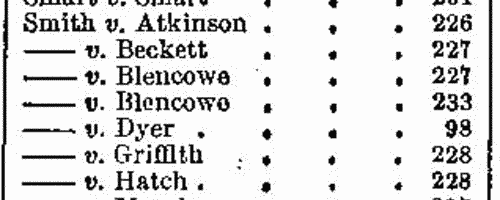
| Boys entering Fettes College, Edinburgh
(1887)
Fettes College, Edinburgh, was opened in 1870 under the terms of a trust 'for maintenance, education, and outfit of young people whose parents have either died without leaving sufficient funds for that purpose, or who, from innocent misfortune during their own lives, are unable to give suitable education to their children'. In 1923 this edition of the Fettes College Register was published; in it the compilers sought to set out for each boy who had attended the college a brief synopsis of what was known about his time at the school, his subsequent career, and date and place of death, or address as of 1923. After each name there is a letter in brackets indicating the house to which the pupil belonged - (C.) Carrington House; (G.) Glencorse House; (K.) Kimmerghame House; (M.) Moredun House; (S.) Schoolhouse. An asterisk indicates that the boy was a foundationer, i. e. supported by the foundation; a dagger that he was a foundation scholar. VIA. indicates Upper Form; Mods. Modern School; Army Cl., Army Class; S. P., School Prefect; xx. First Rugby Football Twenty; xv. First Rugby Football Fifteen; xx. cap. Caps occasionally given to the five (or fewer) next to the First Fifteen after 1875; xi. First Cricket Eleven; viii. Gymnastic Eight; Trs. Prizes and Exhib., Trustees' Prizes and Exhibitions; Govs. Prizes and Exhib., Governors' Prizes and Exhibitions; Schol., scholarship; M., married. Month and year of birth is given in square brackets. | Sample scan, click to enlarge
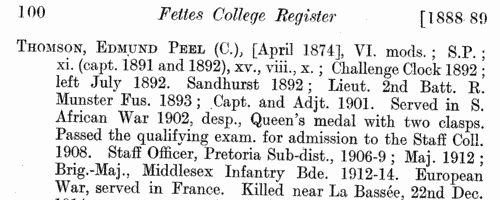
| Debtors, Insolvents and Bankrupts
(1887)
Bills of sale (binding assets to a creditor/lender), insolvencies and bankruptcies in England and Wales, July to September 1887 | Sample scan, click to enlarge

| Boys entering Harrow School
(1889)
This Second Volume of the Second Series of the Harrow School Register was edited by J. H. Stogdon and published in 1925. The boys are listed by term of entrance, and then alphabetically by surname and christian names (in bold). Next, in brackets and in italics, is the school house to which he belonged - or, H. B. indicating a day boy whose family lived in Harrow. Stogdon then gives the father's surname and initials, and address. In cases where the boy was prominent in sports at school, or won academic prizes, scholarships &c., that is given; then the year of leaving the school; a synopsis of his career; and, where known, his address as of 1925, in italics. | Sample scan, click to enlarge
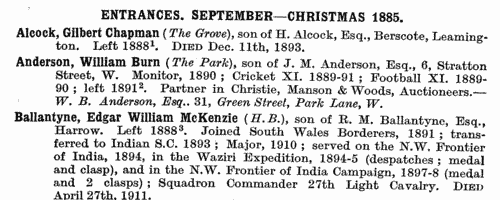
| Actresses
(1891)
The Dramatic Year Book for 1891 includes this list of actresses, giving full name and address or agent's name. | Sample scan, click to enlarge

| Residents of Surrey
(1895)
Kelly's Directory of Surrey includes this alphabetical Court Directory, listing private residents in the county. In fact, this listing is a little more comprehensive than the main directory, in that it includes residents of some London suburbs that, although in the county of Surrey, are not included in the Surrey directory. Residents are listed surname first, then christian name or initials, and postal address. | Sample scan, click to enlarge

| Steam Engine Makers in England
(1898)
The report of the Steam Engine Makers Society includes accounts of disbursements by all their branches (mostly in England), covering members' sickness, travel and funeral expenses. | Sample scan, click to enlarge
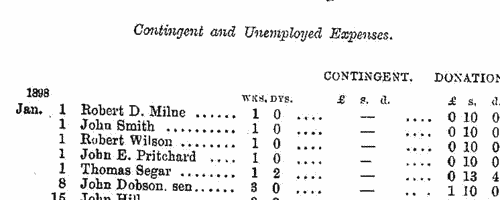
|  Outstanding soldiers of The Prince Albert's (Somerset Light Infantry)
(1881-1901) Outstanding soldiers of The Prince Albert's (Somerset Light Infantry)
(1881-1901)
Each year the best soldiers of the regiment were chosen for long service and good conduct medals. This register gives rank, name, regimental number, and date of recommendation. (The sample scan is from the East Surrey regiment). The register is essentially a register of recommendations, annotated with details of the issue of the medals. Where no gratuity accompanied the medal, the entry is marked 'W. G.' (without gratuity); where, for one reason or another, the medal was not issued, the entry is marked 'N. S.' (not sanctioned) and struck through. The regiment was based on the 13th Regimental District - Taunton. The 1st battalion returned from South Africa in 1879, and by 1885 was based at Enniskillen. It embarked for Gibraltar 12 November 1891, going on to India in 1893, where it was at Umballa in Bengal by 1895. The 2nd battalion embarked for India (via Malta) 27 July 1877, moving on to Burma in 1883, and in 1885 was stationed at Rangoon ("Burma, 1885-1887"); it returned to India in 1887 and to England in 1894. In 1895 it was at Devonport. The battalion was sent out to South Africa in 1899, and added "South Africa, 1899-1902" and "Relief of Ladysmith" to the regimental honours. | Sample scan, click to enlarge
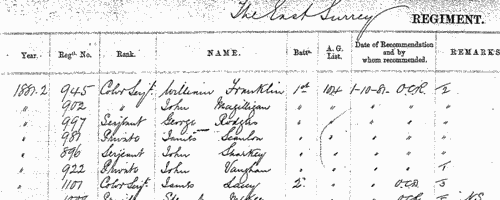
|
Research your ancestry, family history, genealogy and one-name study by direct access to original records and archives indexed by surname.
|












